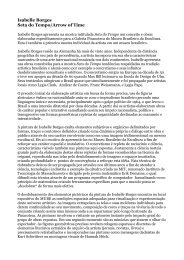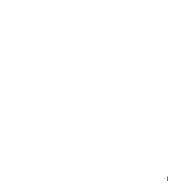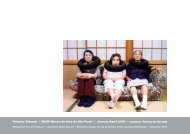Rosilene Luduvico - Lugar sem nome Lugar de origem A vitória nos ...
Rosilene Luduvico - Lugar sem nome Lugar de origem A vitória nos ...
Rosilene Luduvico - Lugar sem nome Lugar de origem A vitória nos ...
Create successful ePaper yourself
Turn your PDF publications into a flip-book with our unique Google optimized e-Paper software.
consi<strong>de</strong>ração que esta seja imensamente manipulada por imagens baseadas<br />
supostamente na realida<strong>de</strong>. Elas porém são provenientes das nova mídias,<br />
cinema, outdoors, fotografia, ví<strong>de</strong>o ultrapassando as fronteiras entre realida<strong>de</strong> e<br />
ficção alterando assim o discernimento das informações obtidas. Esta avalanche<br />
impe<strong>de</strong> a percepção da paisagem, som, local e tempo entre outros criando<br />
contextos <strong>de</strong>turpados. O crítico <strong>de</strong> arte e autor <strong>de</strong>sta publicação Christoph<br />
Tannert, sugere então o <strong>de</strong>saceleramento <strong>de</strong>ste processo para o retorno a uma<br />
percepção mais autêntica 22 . Eu diria que esta tentativa está sendo efetuada a<br />
exemplo da experiência vivenciada por <strong>Rosilene</strong> <strong>Luduvico</strong> na efetivação das<br />
obras que compõem a mostra “<strong>Lugar</strong> <strong>sem</strong> Nome”, o que é em si sua forma usual<br />
<strong>de</strong> atuação introspectiva.<br />
Como já citado anteriormente <strong>Rosilene</strong> <strong>Luduvico</strong> reúne em sua obra<br />
características românticas e contemporâneas em plena harmonia. Sua linguagem<br />
é internacional e não necessariamente com embasamento exclusivamente na<br />
Europa on<strong>de</strong> vive ou na América Latina <strong>de</strong> on<strong>de</strong> vêm. Aliás uma das<br />
características mais marcantes da arte contemporânea latino-americana 23 é a<br />
aproximação e diálogo com tendências internacionais. Posso aqui por exemplo<br />
visualizar em termos <strong>de</strong> contemporanida<strong>de</strong> um intenso diálogo entre obras <strong>de</strong><br />
<strong>Rosilene</strong> <strong>Luduvico</strong> e Peter Doig, o qual abandonou a vida em Londres em busca<br />
<strong>de</strong> inspiração nas montanhas em Trinidad. Suas pinturas atuais também são<br />
repletas <strong>de</strong> características românticas com indivíduos isolados imersos na<br />
paisagem e posicionados <strong>de</strong> costas para o observador 24 .<br />
22<br />
“Today, I find that the most interesting artists are those who work in accordance with the principle of<br />
“out of time”: painters who <strong>de</strong>fend their activities within the expanding area of digital, visual art. “out of<br />
time” could be interpreted as meaning “outsi<strong>de</strong> of the time axis” or “away from the old game”.<br />
Inaccessibility is the preservative of the paintings. These have taken escaping from the tread-mill of doing<br />
the same over and over again as their position. Scepticism of the everyday state of affairs seems to be<br />
appropriate. The daily rat-race often bor<strong>de</strong>rs on the <strong>de</strong>struction of the self. On the other hand, the<br />
constitution of the self could be found in a <strong>de</strong>celeration of the speed of life”. Christoph Tannert: Neue<br />
Deutsche Malerei, Prestel: Munique, 2007, 44.<br />
23<br />
O intercâmbio artistico tem sido muito intenso principalmente <strong>de</strong>s<strong>de</strong> o século XX. Po<strong>de</strong>mos citar por<br />
exemplo Tarsila do Amaral, quem realizou seus primeiros estudos em Barcelona. Após retornar ao Brasil<br />
fez parte do “grupo dos cinco” com Anita Mafalti, Menotti <strong>de</strong>l Picchia, Oswald e Mario <strong>de</strong> Andra<strong>de</strong>,<br />
atuantes na Semana <strong>de</strong> Arte Mo<strong>de</strong>rna <strong>de</strong> 1922. Surge aí momentos marcantes da mo<strong>de</strong>rnida<strong>de</strong> brasileira.<br />
Outro exemplo é o artista Alfredo Volpi, pintor italiano <strong>de</strong> re<strong>nome</strong> internacional. Se mudou com a família<br />
para o Brasil com 18 meses <strong>de</strong> ida<strong>de</strong>. A partir <strong>de</strong> 1911 passou a criar murais didaticamente. Sua pintura é<br />
toda baseada na tradição popular através <strong>de</strong> festas tradicionais com um respaldo em vestígios do período<br />
colonial especialmente pela reprodução <strong>de</strong> fachadas típicas <strong>de</strong>sta época. O cotidiano também era para Volpi<br />
sua maior fonte <strong>de</strong> inspiração.<br />
24<br />
„The caracters that populate Doig`s worlds renew a romantic theme, that of the relation ship between<br />
the individual and nature. Primarily, however, they put well-known patterns to the test. They turn their<br />
backs on the viewer or lie dawn flat, in line with the pictorial plane, in nature (Daytime Astronomy, 1997-<br />
98), they get lost high-flying or shooting beyond the surface (Olin MK IV, 1995) as though the extension<br />
of the pictorial space here were not merely thematically metaphorical, as if, in fact, the exuberance of the<br />
sporting high spirits could really transcend even the pictorial, object-like limitations”. Gabriele Mackert.<br />
Peter Doig. “Dear Painter, paint me... Painting the Figure since late Picabia. Schirn Kunsthalle Frankfurt.<br />
, Frankfurt a.M., 2002, 182.







